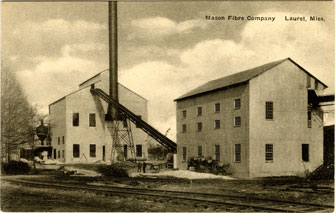
There was a time of innocence in our lives that we will never know again, except, perhaps, in memory.
A time when earth and sky had a rich, clean texture. When grass appeared greener, and flowers were alive and re-splendent with color, and the long-leaf pine trees that adorned the Masonite and Mengel mills stretched far into the sky, and in the late evenings high-flying birds and Kress’ kites floated on the wind and filled the sky with magic.

Weekends, on Laurel’s far south side, in the shadow of the Mengel Furniture Plant—second to Masonite in size of work force, wages, and prestige—held a special enchantment as it sat quietly and majestically at the point of terminus for south Seventh, Eighth and Ninth Avenues along with Heidelberg and Johnson Streets.
The plant’s deep weekend silence was a far cry from the “zing” of saws, the resounding periodic “plop” of boards, “hiss” and “clang” of the electric-powered steam press and the ominous-sounding “hum” made by electric currents coursing through the many wires that laced across the sky and angled into the building and gave the plant its lifeblood five days a week.
Within the imposing late-evening quietness of Mengel, neighborhood children played games on unpaved streets under the relaxed, satisfying, protective survey of parents and other adults who sat in swings, porch chairs and on steps as they watched from the periphery.
They practiced, inadvertently, the old African adage: “It takes a village to raise a child.” These were their children. They belonged to the neighborhood that was in the purview of the Mengel mill. This was their village.
There was a cacophony of sounds emanating from the ebb and flow of children’s games which included Townball and Catchbatter.
Townball was similar to softball, except a stick or a broom handle was used as a bat. A rubber ball was also used. The hitter or baserunner could be forced out by catching a hit ball or by being tagged or hit with the ball itself as the runner advanced from base to base in an attempt to reach home plate and score.
In Catchbatter, again, a rubber ball was used, and a stick or a broom handle served as a bat, but the goal was simply getting a turn at bat by catching a hit ball on the fly by outfield players. The infielders and catcher could also advance to bat by catching a hit ball on the fly or on one hop.
There were no gloves used, and any number of players could participate. There were numerous other games in the children’s repertoire, but these two were the most popular. The boys and girls in the shadow of Mengel who played their games with gusto were in many ways like their counterparts in Kingston and north Laurel; in Queensburg and the west side, in the cotton mill area and the K. C. Bottom; in Dunagin, Newcomers and Halberts Quarters. They were children all. They played their games “all out,” but the winds of change were in the air, and their age of innocence was soon to be on the wane.
It has been said that “change is the only constant.” As the years moved inexorably toward the midpoint of the 20th century, it stole upon us, carried us along, then exploded—Korea, cars, paved streets, black and white television, antennas, soap operas, tragedies, strikes, unemployment, out-migration, natural attrition, social revolution, color television, Vietnam, man on the moon and computers.
Memory crosses the chasm of time and space. Memory takes us back—flowers, resplendent with color; birds and kites on the wind; Masonite and Mengel; pine trees swaying in the distance; converging thoroughfares; sounds; weekend quietness; children at play; adults on the periphery.
A montage of impressions stop, merge, and freeze into a single frame that is at once distant, yet as close as a painter’s brush on canvas.
There was a time of innocence in our lives that we will never know again, except, perhaps, as memory.
Laurel, Mississippi native Cleveland Payne wrote a weekly column for "The Laurel Leader-Call" in the mid-1990s, which culminated in his book, "Laurel Remembrances." This is one of his essays from that book. Cleveland is also the author of other stories about growing up in the South.
For more information about Cleveland's books, visit his Website at www.clevelandpaynebooks.com. This will open a new page.
COPYRIGHT © 2010 THE NEW SOUTHERN VIEW | 4/13/10


